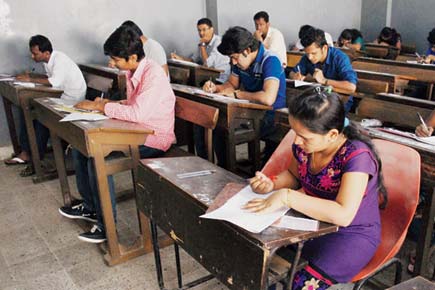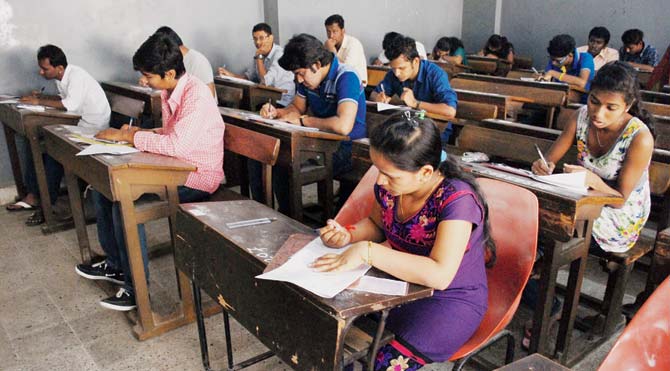Between 2010-11 and 2015-16, student enrolment in government schools across 20 states fell by 13 million, while private schools acquired 17.5 million new students, according to a new study that offers insights into India's public-school education crisis


Representational pic
ADVERTISEMENT
Between 2010-11 and 2015-16, student enrolment in government schools across 20 states fell by 13 million, while private schools acquired 17.5 million new students, according to a new study that offers insights into India's public-school education crisis.
Average enrolment in government schools -- where teachers are paid, on average, salaries that are four times those in China -- declined from 122 to 108 students per school over five years, while it rose from 202 to 208 in private schools, according to a research paper by Geeta Gandhi Kingdon, professor of education and international development at the Institute of Education, London.
Yet, 65 per cent of all school-going children in the 20 states, about 113 million, continue to get their education from government schools, according to District Information System for Education (DISE) and Ministry of Education data.
Why are students opting out of government schools, which educate the poorest and most vulnerable students until the age of 14 for free, and migrating to fee-charging private institutions in such large numbers?
The study, which uses DISE data, traced this student migration to the belief among parents that private schools offer better value for money and better teaching. Multiple evaluations after controlling for students' home backgrounds indicate that "children's learning levels in private schools are no worse than, and in many studies better than, those in government schools", said Gandhi.
Despite the Rs 1.16 lakh crore ($17.7 billion) spent on Sarva Shiksha Abhiyan (SSA) -- the national programme for universal elementary education -- the quality of learning declined between 2009 and 2014.
Less than one in five elementary school teachers are trained. In Delhi, capital city and its richest state, by per capita income, half of all government-school teachers are hired on temporary contracts. They are likely to be less motivated and accountable than teachers with full-time jobs.
The preference for private school education and the differences in learning outcomes of private and government schools vary between states. For instance, in 2015-16, in Uttar Pradesh, over 50 per cent of children studied in private schools, while in Bihar, less than four per cent of children attended private schools, according to DISE data.
In 2016, in Kerala, the proportion of children (aged 11-14) enrolled in government schools increased from 40.6 per cent in 2014 to 49.9 per cent. In Gujarat too, it increased, from 79.2 per cent in 2014 to 86 per cent, according to the Annual Status of Education Report (ASER) 2016 data. ASER is a learning assessment of children in rural India.
In Punjab, Gujarat, Maharashtra, Andhra Pradesh and Karnataka, government schools outperformed private schools in reading skills in local languages, once household and parental characteristics were controlled for, according to a state-wise analysis in ASER 2014.
In Kerala and Tamil Nadu, where government schools were better than private schools to start with, learning outcomes improved between 2011 and 2014, once other factors were accounted for.
States with better-functioning government schools have more elite -- that is, more expensive -- private schools because there is no market here for the "low-fee" budget private schools that have been sprouting across the country, Gandhi's study said.
This explains why in poorer states, such as Bihar, Madhya Pradesh, Rajasthan, Uttar Pradesh and Orissa, about 70 per cent to 85 per cent of children studying in private unaided schools pay less than Rs 500 per month as school fees. Up to 80 per cent of private schools are "low" fee schools when benchmarked against per capita and daily wagers' incomes, the data show.
In 2016, for the first time in 10 years, private-school enrolment did not increase in rural areas -- it fell from 30.8 per cent in 2014 to 30.5 per cent in 2016, according to the ASER 2016 report. But this has not stemmed the growth of private schools nationwide.
Between 2010-11 and 2015-16, the number of private schools grew 35 per cent, while the number of government schools grew one per cent. Section 6 of the Right to Education Act 2009 legally obligates states to create more government schools.
The migration out of government schools has left many unviable, with high per-pupil expenditure, and low value-for-money from public education expenditure. About 24,000 government schools across Rajasthan, Maharashtra and Chhattisgarh have closed, according to the study.
India's government teachers earn more than not just their counterparts in private schools but also in other countries, Gandhi's analysis shows.
Despite being paid at least four times the salaries of teachers in China (in terms of multiples of their respective per capita incomes), the performance of Indian teachers judged in terms of their students' learning levels, has been poor in the Programme for International Student Assessment (PISA) test in 2009, with India ranking 73rd and China ranking 2nd, among 74 countries.
Up to 80 per cent of India's public expenditure on education is spent on teachers -- salaries, training and learning material, according to a six-state report. Teacher salaries in of teachers in Uttar Pradesh are four to five times India's per capita gross domestic product (GDP) and more than 15 times the state's, according to a 2013 analysis by Amartya Sen and Jean Dreze. This is much higher than the salaries paid to teachers in OECD countries and India's neighbours.
"This suggests the need to link future teacher salary increases to the degree of teachers' acceptance of greater accountability, rather than across-the board increases irrespective of performance or accountability," said Gandhi.
The private education sector offers salaries based on market factors of demand and supply, said Gandhi, and given that there is a 10.5 per cent graduate unemployment rate in India, jobless graduates are willing to settle for low salaries in private schools.
A common suggestion is increasing India's spending on education. In 2015-16, central government spending on school and higher education was less than other BRICS countries -- India spent three per cent of its GDP on education, compared to Russia (3.8 per cent), China (4.2 per cent), Brazil (5.2 per cent), and South Africa (6.9 per cent).
However, increased government spending in education is not enough to improve educational outcomes. Between 2006 and 2013, public expenditure on school education increased from 2.2 per cent to 2.68 per cent of GDP. The education policy must be thoroughly revised to put in place better accountability and monitoring mechanisms to exploit the gains of increase in fiscal outlays on education.
Public private partnership (PPP) model may be the solution, Gandhi argued, combining the best of both worlds-public sector funding and private resources for education.
Before choosing any particular form of educational PPP, India must study these different designs and their relevance/applicability/adaptability, and must also pilot test the chosen models before scaling up any novel intervention, Gandhi suggested in her paper.
 Subscribe today by clicking the link and stay updated with the latest news!" Click here!
Subscribe today by clicking the link and stay updated with the latest news!" Click here!






